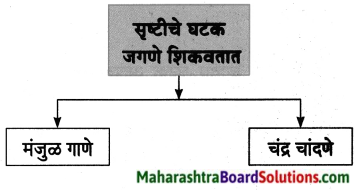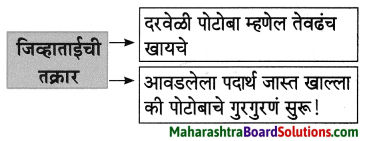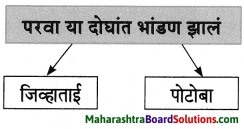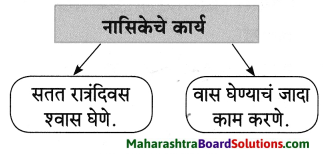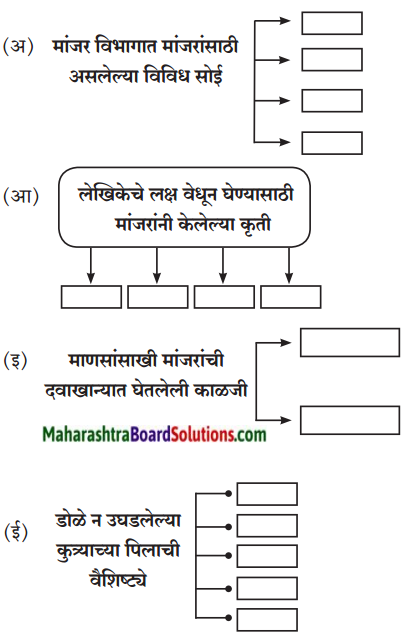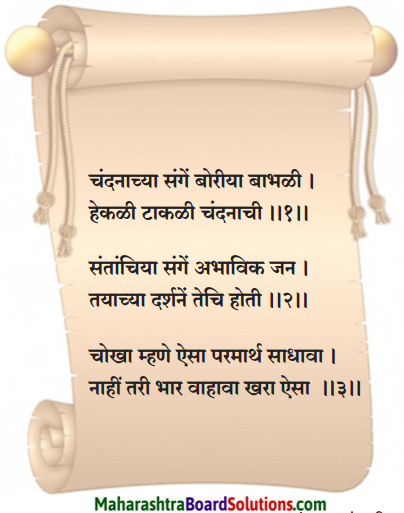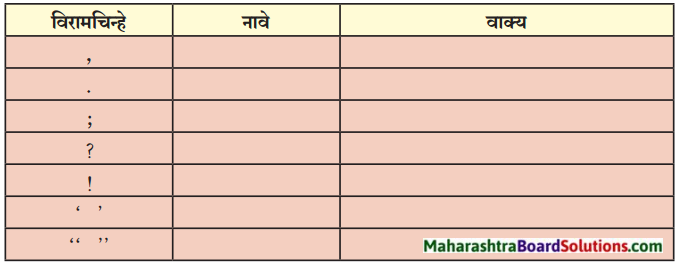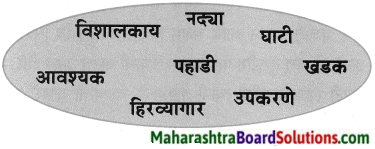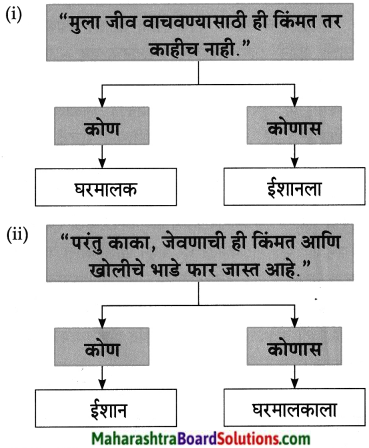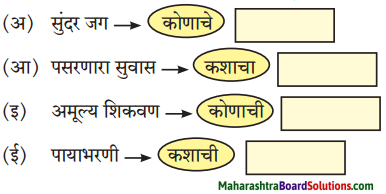Balbharti Maharashtra State Board Class 8 Marathi Solutions Sulabhbharati Chapter 2 मी चित्रकार कसा झालो! Notes, Textbook Exercise Important Questions and Answers.
Class 8th Marathi Chapter 2 मी चित्रकार कसा झालो! Question Answer Maharashtra Board
Std 8 Marathi Chapter 2 Question Answer
Marathi Sulabhbharti Class 8 Solutions Chapter 2 मी चित्रकार कसा झालो! Textbook Questions and Answers
1. उत्तर लिहा.
लेखकाने पाठात कलेसंबंधी वर्णिलेले दोन विषय-
प्रश्न 1.
लेखकाने पाठात कलेसंबंधी वर्णिलेले दोन विषय-
उत्तरः
1. चित्रकला
2. मूर्तिकला
2. काय ते सांगा.
प्रश्न अ.
मूर्तीला तडे जाऊ नये यासाठी लेखकाला सापडलेला उपाय.
उत्तर:
- मातीत गाईचे शेण मिसळणे.
- नंतर मातीत घोड्याची लीद मिसळणे.
![]()
प्रश्न आ.
लेखकाचा कॅनव्हास..
उत्तर:
पाण्याच्या प्रवाहामुळं गुळगुळीत, सपाट झालेले, लांबरुंद पसरलेले खडक.
3. आकृत्या पूर्ण करा.

प्रश्न 1.
आकृत्या पूर्ण करा.

उत्तर:
आ.

आ.

4. योग्य जोड्या जुळवा.
प्रश्न 1.
| ‘अ’ गट | ‘ब’ गट |
| 1. पिवळा | (अ) झाडांच्या पानापासून |
| 2. जांभळा | (आ) दगडांपासून |
| 3. भगवा | (इ) काटेसावरीच्या फुलातील परागकणांपासून |
| 4. हिरवा | (ई) शेंदरी झाडाच्या बियांपासून |
उत्तर:
| ‘अ’ गट | ‘ब’ गट |
| 1. पिवळा | (आ) दगडांपासून |
| 2. जांभळा | (इ) काटेसावरीच्या फुलातील परागकणांपासून |
| 3. भगवा | (ई) शेंदरी झाडाच्या बियांपासून |
| 4. हिरवा | (अ) झाडांच्या पानापासून |
![]()
5. एका शब्दांत उत्तर लिहा.
प्रश्न 1.
एका शब्दांत उत्तर लिहा.
उत्तर:
- बांबूच्या कोवळ्या काडीपासून तयार व्हायचा – [ब्रश]
- चित्र काढण्यासाठी वापरला जाणारा कागद – [कॅनव्हास]
- लालभडक मातीपासून तयार केल्या जायच्या – [मूर्ती]
- ओल असताना जसे असते तसेच वाळल्यावरही असते – [गाईचं शेण]
- घोड्याच्या शेणाला म्हणतात – [लीद]
6. ‘तुमच्या इच्छा तीव्र असतील तर साधनांशिवाय साधना करता येते’ या विधानाचा तुम्हाला समजलेला अर्थ लिहा.
प्रश्न 1.
‘तुमच्या इच्छा तीव्र असतील तर साधनांशिवाय साधना करता येते’ या विधानाचा तुम्हाला समजलेला अर्थ लिहा.
उत्तरः
इच्छाशक्तीच्या जोरावर माणूस अशक्य ते शक्य करू शकतो, फक्त त्याच्या आतील इच्छाशक्ती प्रबळ असली पाहिजे. उदाहरणार्थ : परीक्षेत चांगले गुण मिळावेत म्हणून काही ट्युशन व क्लास लावण्याची गरज नाही. कोणत्याही विद्यार्थ्याने वर्गात शिकवतानाच लक्ष देऊन जर तो भाग, विषय समजून घेतला आणि स्वत: अभ्यास करून परीक्षेची तयारी केली तर त्यास चांगले गुण मिळू शकतात. फक्त त्याच्या मनात अभ्यास, सराव, पाठांतर करण्याची प्रबळ इच्छा हवी.
एखादया मातीच्या गोळ्यापासून मूर्ती बनवण्यासाठी काही प्रशिक्षण घेण्याचीच गरज नसते. ती कला आपल्या बोटात उपजतच असते फक्त तिला ओळखून प्रयत्न करणे महत्त्वाचे असते. अशी कितीतरी उदाहरणे आहेत की थोर मूर्तीकार कोणत्याही मूर्तीकलेच्या शाळेत न जाता त्यांच्या हातून चांगल्या प्रतीच्या मूर्ती घडल्या गेल्या आहेत. म्हणून मनात तीव्र इच्छा असेल तर कोणत्याही साधनांशिवाय कलेची साधना आपणांस करता येते असे म्हणता येईल.
![]()
खेळ्या शब्दांशी.
खाली दिलेल्या शब्दांतून नाम व विशेषणे ओळखून त्यांच्या योग्य जोड्या लावा.
प्रश्न 1.
खाली दिलेल्या शब्दांतून नाम व विशेषणे ओळखून त्यांच्या योग्य जोड्या लावा.

उत्तर:
निळे – डोंगर, दाट – सावली, हिरवी – राने
![]()
शोध घेऊया.
विविध झाडांपासून रंग तयार केले जातात त्याची आंतरजालाच्या मदतीने माहिती मिळवा.
प्रश्न 1.
विविध झाडांपासून रंग तयार केले जातात त्याची आंतरजालाच्या मदतीने माहिती मिळवा.
चर्चा करूया.
प्रत्येकाच्या अंगी काही ना काही कला असते. तुमच्या मित्र-मैत्रिणींसमवेत त्यांना आवडणाऱ्या गोष्टींविषयी (कला) चर्चा करा. ती गोष्ट त्यांना करायला का आवडते? यामागील कारणे समजून घ्या.
उपक्रम : तुमच्या परिसराचे निरीक्षण करा. परिसरातील विविध घटकांपासून तुम्हाला काय काय शिकायला मिळते, त्याची
नोंद करा.
आपण समजून घेऊया.
वाक्य म्हणजे काय?
संपूर्ण अर्थ व्यक्त करणाऱ्या शब्दसमूहाला वाक्य म्हणतात. वाक्याचे दोन भाग असतात. ज्याच्याविषयी सांगायचे ते उद्देश्य आणि जे सांगायचे ते म्हणजे विधेय.
‘त्याचा मोठा मुलगा दररोज आगगाडीने मुंबईला जातो.’
या वाक्यात मुलाविषयी सांगायचे आहे, म्हणून ‘मुलगा’ हे उद्देश्य, तर ‘जातो’ हे विधेय आहे. या वाक्यातील ‘त्याचा’, ‘मोठा’ हे शब्द उद्देश्याचा विस्तार आहेत, तर ‘दररोज’, ‘आगगाडीने’ हे शब्द विधेयाचा विस्तार आहेत.
![]()
वाक्यांचे विविध प्रकार आहेत. त्यातील काही वाक्य प्रकारांची माहिती आपण करून घेणार आहोत.
1. विधानार्थी वाक्य
ही वाक्ये वाचा.
(अ) माझे घर दवाखान्याजवळ आहे.
(आ) तो रोज व्यायाम करत नाही.
या प्रकारच्या वाक्यांत केवळ विधान केलेले असते.
2. प्रश्नार्थी वाक्य
ही वाक्ये वाचा.
(अ) तुला लाडू आवडतो का?
(आ) तुम्ही सकाळी कधी उठता?
या प्रकारच्या वाक्यांत प्रश्न विचारलेला असतो.
3. उद्गारार्थी वाक्य
ही वाक्ये वाचा.
(अ) अरेरे ! फार वाईट झाले.
(आ) शाबास ! चांगले काम केलेस. या प्रकारच्या वाक्यांत भावनेचा उद्गार काढलेला असतो.
4. आज्ञार्थी वाक्य
ही वाक्ये वाचा.
(अ) मुलांनो, रांगेत चला.
(आ) उत्तम आरोग्यासाठी व्यायाम करा. या प्रकारच्या वाक्यांत आज्ञा किंवा आदेश असतो.
![]()
वर दिलेल्या चारही प्रकारांतील वाक्यांचे नमुने तयार करा.
प्रश्न 1.
वर दिलेल्या चारही प्रकारांतील वाक्यांचे नमुने तयार करा.
Marathi Sulabhbharti Class 8 Solutions Chapter 2 मी चित्रकार कसा झालो! Important Additional Questions and Answers
पुढील उताऱ्याच्या आधारे दिलेल्या सूचनेनुसार कृती करा.
कृती 1: आकलन कृती
1. कोण ते लिहा.
- जे अनुभवलं, पाहिलं ते तुम्हाला सांगणारे – [ल. म. कडू]
- आपल्याला नाना कला शिकवतो – [निसर्ग]
2.कृती पूर्ण करा.
- विरोधात न जाता मर्जीत राहणं केव्हाही फायद्याचे असणारा – [निसर्ग]
- निसर्गातून आपलं होतं – [पालनपोषण]
- सर्जनाच्या वाटा आपसूक सापडतील – [निसर्ग धुंडाळत राहिल्याने]
![]()
3. वेब पूर्ण करा.
(i)

(ii)

एका वाक्यात उत्तरे लिहा.
प्रश्न 1.
लेखकाने कोणाची गोष्ट सांगितली?
उत्तरः
लेखकाने स्वत:चीच गोष्ट सांगितली.
प्रश्न 2.
लेखकाचे प्राथमिक शिक्षण कोठे झाले?
उत्तर:
लेखकाचे प्राथमिक शिक्षण लहानशा खेड्यात झाले.
![]()
कृती 2 : आकलन कृती
प्रश्न 1.
विशेषण व विशेष्य यांच्या जोड्या जुळवा.
| ‘अ’ विशेषण | ‘ब’ विशेष्य |
| 1. घनदाट | (अ) डोंगर |
| 2. दुथडी | (आ) रानं |
| 3. निळे | (इ) जंगलं |
| 4. हिरवी | (ई) नदी |
उत्तर:
| ‘अ’ विशेषण | ‘ब’ विशेष्य |
| 1. घनदाट | (इ) जंगलं |
| 2. दुथडी | (ई) नदी |
| 3. निळे | (अ) डोंगर |
| 4. हिरवी | (आ) रानं |
![]()
प्रश्न 2.
कृती पूर्ण करा.
(i)

(ii)

(iii)
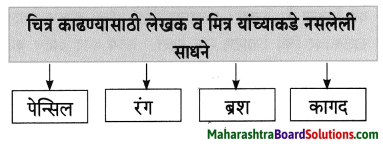
3. आकृतिबंध पूर्ण करा.
(i)

(ii)

4. चौकटी पूर्ण करा.
(i)

(ii)

कृती 3: व्याकरण कृती
प्रश्न 1.
खालील शब्दांचे वचन बदलून लिहा.
- वाटा
- खेडं
- गोष्ट
- नदी
- डोंगर
- रानं
- साधन
- पेन्सिल
- वही
- चित्र
उत्तर:
- वाट
- खेडी
- गोष्टी
- नदया
- डोंगर
- रान
- साधने
- पेन्सिली
- वया
- चित्रे
![]()
प्रश्न 2.
खालील शब्दांचे लिंग ओळखून लिहा.
- निसर्ग
- कला
- वाट
- गोष्ट
- खेडे
- नदी
- डोंगर
- रान
- ब्रश
- कागद
उत्तर:
- पुल्लिंग
- स्त्रीलिंग
- स्त्रीलिंग
- स्त्रीलिंग
- नपुसकलिंग
- स्त्रीलिंग
- पुल्लिंग
- नपुसकलिंग
- पुल्लिंग
- पुल्लिंग।
प्रश्न 3.
खालील शब्दांचे समानार्थी शब्द लिहा.
- वाट
- गोष्ट
- खेडे
- नदी
- नवल
- साधन
- धाक
- वात्रटपणा
उत्तर:
- रस्ता, मार्ग
- कथा, कहाणी
- गाव
- सरिता
- आश्चर्य
- सामग्री
- जरब, वचक
- खोडकरपणा
![]()
प्रश्न 4.
खालील वाक्यातील विरामचिन्हे ओळखून त्यांची नावे लिहा. माझा एक मित्र होता.
आम्हाला खूप वाटायचं, की आपण चित्रं काढावीत; पण काय करणार? आमच्याकडे कसलीच साधनं नव्हती.
उत्तर:
| विरामचिन्हे | विरामचिन्हांचे नाव |
| (.) | पूर्णविराम |
| (,) | स्वल्पविराम |
| (;) | अर्धविराम |
| (?) | प्रश्नचिन्ह |
प्रश्न 5.
खालील वाक्यांतील अधोरेखित शब्दांची जात ओळखून लिहा.
प्रश्न i.
आता तुम्हांला माझीच गोष्ट सांगतो.
उत्तर:
- तुम्हांला – सर्वनाम
- गोष्ट – सामान्य नाम
![]()
प्रश्न ii.
माझा एक मित्र होता.
उत्तर:
- एक – विशेषण
- होता – क्रियापद
कृती 4: स्वमत
प्रश्न 1.
चित्र काढण्याबाबत लेखक व मित्र यांना आलेल्या अडचणी तुमच्या शब्दांत लिहा.
उत्तर:
लेखकांचा एक मित्र होता. दोघांनाही खूप वाटायचे, की आपण चित्रं काढावीत; पण चित्र काढण्यात त्यांना खूप अडचणी यायच्या. त्यांच्याकडे चित्रं काढण्यासाठी लागणारी कसलीच साधनं नव्हती. पेन्सिल, रंग, ब्रश हे तर सोडाच साधा कागदही नव्हता. अभ्यासाची एकच वही व पाटीवर लिहिण्याची एकच पेन्सिल, त्यातही तिचे तुकडे झाले, तरी सांभाळून वापरावी लागायची, कारण दुसरी मिळण्याची शक्यता नव्हती. शिवाय सगळ्यात मोठी अडचण किंवा धाक असा होता, की चित्रंबित्रं काढलेली ना मास्तरांना आवडायची ना घरातल्यांना आवडायची. त्यांना तो वात्रटपणा वाटायचा. इत्यादी अडचणी त्यांना येत.
![]()
पुढील उताऱ्याच्या आधारे दिलेल्या सूचनेनुसार कृती करा.
कृती 1: आकलन कृती
प्रश्न 1.
खालील कृती पूर्ण करा.
(i)

(ii)
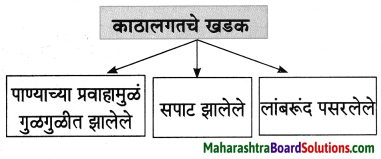
प्रश्न 2.
परिणाम लिहा.
प्रश्न i.
वैशाख महिन्यातलं ऊन करपवून टाकणारं असायचं
उत्तर:
गावातली सगळी मुलं नदीच्या डोहात जाऊन पडायची.
![]()
प्रश्न ii.
नदी वाहायला लागायची
उत्तर:
खडकावर काढलेली चित्रं नदीच्या पोटात गडप व्हायची.
प्रश्न 3.
आकृतिबंध पूर्ण करा.
(i)

(ii)

प्रश्न 4.
कंसातील योग्य शब्द निवडून रिकाम्या जागा भरा.
- काठालगत खूप ………………. होते. (दगड, खडे, खडक, शिंपले)
- गुडघ्यावर टेकून रेष काढण्यात ………………… व्हायचो. (दंग, मग्न, लीन, नम्र)
- आमची चित्रं नदीच्या पोटात ………………. व्हायची. (गायब, गडप, नाहिशी, बेभान)
उत्तर:
- खडक
- दंग
- गडप
![]()
प्रश्न 5.
चौकटी पूर्ण करा.
- लेखकानं खडकासाठी वापरलेला शब्द → [कॅनव्हास]
- मरुमाचा रंग → [तांबूस]
- पिवळट रंगाचे → [दगड]
कृती 2 : आकलन कृती
1. काय होते ते लिहा.

2. पुढील कृती पूर्ण करा.
(i)

(ii)

(iii)

3. फक्त नावे लिहा.
i. उताऱ्यात आलेल्या दोन वनस्पती → [काटेसावर, शेंदरी]
ii. तापलेल्या खडकावर टेकून टेकून गुडघ्यांची जातात → [सालों]
![]()
4. आकृतिबंध पूर्ण करा.
i. लेखकाच्या लक्षात न येणारी गोष्ट → खडकावर टेकून टेकून गुडघ्याची सालटं गेलेली.
ii. लेखक तहानभूक हरपून ही गोष्ट करीत → चित्र रंगवत बसायचे.
कृती 3 : व्याकरण कृती
प्रश्न 1.
विरोधी अर्थाचे शब्द लिहा.
- ऊन × [ ]
- गार × [ ]
- गुळगुळीत × [ ]
- लांब × [ ]
- सापडणे × [ ]
- थोरला × [ ]
- ओला × [ ]
- मागे × [ ]
- लक्ष × [ ]
- दिवस × [ ]
- कोवळा × [ ]
- थोडे × [ ]
उत्तर:
- सावली
- गरम
- ओबडधोबड़
- रुंद, जवळ
- हरवणे
- धाकटा
- सुका
- पुढे
- दुर्लक्ष
- रात्र
- जुन
- जास्त
![]()
प्रश्न 2.
परिच्छेदात आलेले जोडशब्द लिहा.
उत्तर:
- गुळगुळीत
- लांबलंद
- भल्याथोरल्या
- तहानभूक
- लालभडक
प्रश्न 3.
खालील वाक्यांचे प्रकार ओळखा.
- काठालगत खूप खडक होते.
- काही दिवसांनी वाटायला लागलं, की यात रंग भरावेत; पण ते कुठून आणणार?
उत्तर:
- विधानार्थी वाक्य
- प्रश्नार्थी वाक्य
![]()
प्रश्न 4.
खालील वाक्यांचा काळ ओळखा.
- आम्हांला तिथंच आमचा कॅनव्हास’ सापडला.
- या भल्या थोरल्या खडकावर मनसोक्त चित्रं काढता येणार होती.
उत्तर:
- भूतकाळ
- भविष्यकाळ
प्रश्न 5.
अधोरेखित शब्दांचे समानार्थी शब्द वापरून वाक्य पुन्हा लिहा.
- गुडघ्यावर टेकून रेष काढण्यात दंग व्हायचो.
- आमची चित्रं नदीच्या पोटात गडप व्हायची.
उत्तर:
- गुडघ्यावर टेकून रेष काढण्यात मग्न व्हायचो.
- आमची चित्रं नदीच्या पोटात गायब व्हायची.
कृती 4 : स्वमत
प्रश्न 1.
खडकावर काढलेल्या चित्रांना रंग देण्यासाठी लेखकांनी कोणत्या गोष्टींचा व कसा वापर केला ते सांगा.
उत्तरः
वैशाख महिन्यात काटेसावर ही वनस्पती फुलते, लालभडक होते. तिच्या फुलातले पराग पाण्यात चुरगळले की जांभळा रंग मिळतो. शेंदरी नावाच्या वनस्पतीच्या बोंडातल्या बिया भगवा रंग देतात. हे लेखकांना माहीत होते. मग लेखकांनी या रंगांचा उपयोग खडकातील चित्रं रंगवण्यासाठी केला. त्याचप्रमाणे काही पानांपासून हिरवा रंग, चुन्याचा पांढरा रंग, कुंकवाचा लाल रंग आणि दगडाचा पिवळा रंग तयार करून, बांबूची कोवळी काडी घेऊन त्याचं पुढचं टोक ठेचून त्याचा ब्रश सारखा वापर करून चित्रे रंगवली.
![]()
पुढील उताऱ्याच्या आधारे दिलेल्या सूचनेनुसार कृती करा.
कृती 1 : आकलन कृती
प्रश्न 1.
पुढील कृती पूर्ण करा.
उत्तरः
- लेखकाने सांगितलेले व्यक्तिगत ते → [उदाहरण]
- किती परीनं आपल्याला देत असतो तो → [निसर्ग]
- लेखकाचं सांगणं → [साधनं नाहीत म्हणून अडून बसण्याचं कारण नाही].
- तुमच्या इच्छा तीव्र असतील तर → [साधनांशिवाय साधना करता येते.]
- उताऱ्यात आलेले दोन महिने – [चैत्र, श्रावण]
खालील प्रश्नांचे एका शब्दात उत्तर लिहा.
प्रश्न i.
पाऊस कधी कमी व्हायचा?
उत्तर:
श्रावण सरता सरता.
प्रश्न ii.
लेखकासाठी ‘कॅनव्हास’ म्हणजे काय?
उत्तर:
खडक
![]()
वेब पूर्ण करा.
(i)

(ii)

कृती 2 : आकलन कृती
प्रश्न 1.
फक्त नावे लिहा.
उत्तर:
- लेखकाला मातीचा लागलेला → [नाद]
- लेखकाने मातीच्या कराव्यात असं ठरवलं ते → [मूर्ती]
- मातीचा लपून छपून करावा लागणारा → [खेळ]
प्रश्न 2.
खालील गोष्टींचा होणारा परिणाम लिहा.
- मूर्ती करून वाळत ठेवल्या, की
- शेण मातीत मळून घेतलं, की
उत्तर:
- काही काळानं त्यांना तडे जाऊन ढासळायच्या.
- आता मूर्ती थोड्या टिकायला लागल्या.
प्रश्न 3.
उताऱ्याच्या आधारे वाक्ये पूर्ण करून लिहा.
- श्रावण सरता सरता पाऊस कमी व्हायचा;
- पण हा मातीचा खेळही
उत्तर:
- श्रावण सरता सरता पाऊस कमी व्हायचा; पण नदी वाहतच असायची.
- पण हा मातीचा खेळही लपून छपून करावा लागे.
![]()
प्रश्न 4.
खालील कृती पूर्ण करा.
उत्तर:
1. गाईचं शेण ओलं व → [जसं असतं तसंच राहतं वाळल्यावरही]
2. चैत्र महिना उजाडायचा → [कॅनव्हास’ म्हणजे खडक मोकळा व्हायला.]
कृती 3 : व्याकरण कृती
खालील वाक्ये शुद्ध करून लिहा.
प्रश्न i.
आम्ही शेन मातीत मळुन घेलतं.
उत्तरः
आम्ही शेण मातीत मळून घेतलं.
प्रश्न ii.
आता हेच पहा, सरावण सरता सरता पावूस कमी व्हायचा.
उत्तर:
आता हेच पहा, श्रावण सरता सरता पाऊस कमी व्हायचा.
अधोरेखित शब्दांचे विरोधी शब्द वापरून वाक्ये पुन्हा लिहा.
प्रश्न i.
मी जे काही व्यक्तिगत सांगतो आहे, ते एक उदाहरण आहे.
उत्तरः
मी जे काही सार्वजनिक सांगतो आहे, ते एक उदाहरण आहे.
![]()
प्रश्न ii.
पण हा मातीचा खेळही लपून छपून करावा लागे.
उत्तरः
पण हा मातीचा खेळही उघड-उघड करावा लागे.
खालील वाक्प्रचारांचा अर्थ सांगून वाक्यात उपयोग करा.
प्रश्न 1.
1. नाद लागणे
2. उपाय शोधणे
उत्तर:
1. नाद लागणे – छंद जडणे, आवड निर्माण होणे
वाक्य: त्यातूनच आम्हांला मातीचे बैल बनवण्याचा नाद लागला.
2. उपाय शोधणे – पर्याय शोधणे
वाक्यः आजारातून बरे होण्यासाठी योग्य उपया शोधणे गरजेचे असते.
खालील वाक्यांतील अव्यय ओळखून त्याचा प्रकार लिहा.
प्रश्न 1.
- मला इतकचं म्हणायचं आहे, की साधनं नाहीत म्हणून अडून बसण्याचं कारण नाही.
- मूर्ती कराव्यात असं ठरलं; पण हा मातीचा खेळही लपून छपून करावा लागे,
उत्तर:
- की – उभयान्वयी अव्यय
- पण – उभयान्वयी अव्यय
![]()
खालील वाक्यांचे प्रकार ओळखून लिहा.
प्रश्न 1.
- तोवर काय करायचं?
- तुमच्या इच्छा तीव्र असतील तर साधनांशिवाय साधना करता येते.
उत्तर:
- प्रश्नार्थी वाक्य
- विधानार्थी वाक्य
पुढील उताऱ्याच्या आधारे दिलेल्या सूचनेनुसार कृती करा.
कृती 1: आकलन कृती
प्रश्न 1.
खालील कृती पूर्ण करा.
उत्तर:
- गावातील बाजार → [आठवडे बाजार]
- आयते कपडे विकायला यायचा → [म्हादु]
- या झाडाची दाट सावली पडायची → [नांदुकीच्या]
![]()
प्रश्न 1.
खालील वेब पूर्ण करा.
(i)

(ii)

(iii)

प्रश्न 2.
खालील वाक्यांतील रिकाम्या जागी योग्य शब्द लिहून वाक्य पूर्ण करा.
- तो झाडाच्या …………….. घोडा बांधून ठेवायचा.
- मी ………………. शाळेत असताना आर्किमीडिज या शास्त्रज्ञाचा धडा वाचला.
उत्तर:
- मुळीला
- माध्यमिक
![]()
प्रश्न 3.
दिलेल्या पर्यायांपैकी योग्य पर्याय निवडून वाक्य पूर्ण करा.
i. लीद म्हणजे ……………..
(अ) बैलाचे शेण
(आ) गाईचे शेण
(इ) घोड्याचे शेण
(ई) म्हशीचे शेण
ii. केवढा आनंद झाला हे मला …………………..
(अ) गक्यात सांगता येणार नाही.
(आ) पक्यात सांगता येणार नाही.
(इ) वाक्यात सांगता येणार नाही.
(ई) शब्दांत सांगता येणार नाही.
उत्तर:
i. लीद म्हणजे घोड्याचे शेण.
ii. केवढा आनंद झाला हे मला शब्दांत सांगता येणार नाही.
![]()
कृती 2 : आकलन कृती
प्रश्न 1.
खालील कृती पूर्ण करा.
उत्तरः
- लेखक माध्यमिक शाळेत असताना या शास्त्रज्ञाचा धडा वाचला – [आर्किमीडिज]
- लेखकांनाशब्दांत सांगतानयेणारा → [झालेला आनंद]
प्रश्न 2.
कारण लिहा.
आता लेखकांच्या मूर्तीना बिलकुल तडे जात नव्हते, कारण………….
उत्तरः
मातीत घोड्याची लीद मिसळली होती. घोड्याच्या लीद मधले धागे माती धरून ठेवत होते.
प्रश्न 3.
एका वाक्यात उत्तर लिहा. आर्किमीडिजला हवं होतं ते तत्व शोधण्यासाठी तो कोणती गोष्ट करत असे?
उत्तर:
आर्किमीडिजला हवं होतं ते तत्त्व शोधण्यासाठी तो साध्या वाटणाऱ्या गोष्टीतही ते शोधत राहायचा.
![]()
प्रश्न 4.
पुढील कृती लिहा.
उत्तर:
1. आर्किमीडिजला हवं होतं ते तत्त्व सापडल्यावर → [तो न्हाणीघरातून ‘युरेका युरेका’ करत धावत सुटला.]
2. जेव्हा मूर्तीना तडे जाण्याचं थांबलं होतं → [तेव्हा लेखकांनाही तेवढाच आनंद झाला होता.]
कृती 3: व्याकरण कृती
प्रश्न 1.
खालील शब्दांचे समानार्थी शब्द लिहा.
- गाव – [ ]
- घोडा – [ ]
- दाट – [ ]
- सावली – [ ]
- धागा – [ ]
- धडा – [ ]
- आभाळ – [ ]
- तडा – [ ]
उत्तर:
- खेडे
- अश्व
- घन
- छाया
- दोरा
- पाठ
- नभ, आकाश
- भेग
![]()
प्रश्न 2.
खालील वाक्यांतील अव्यय शोधून त्याचा प्रकार लिहा.
- तो आपला माल घोड्यावर लादून आणायचा.
- आपल्यापुरता का होईना; पण तो एक शोध होता.
उत्तर:
- वर – शब्दयोगी अव्यय
- पण – उभयान्वयी अव्यय
प्रश्न 3.
खालील शब्दांचे एकवचन व अनेकवचन असे वर्गीकरण करा. (कपडे, आठवडे, पायवाटा, सावली, घोडा, धागे, मूर्ती, तडे, धडा, गोष्टी)
उत्तरः
| एकवचन | अनेकवचन |
| सावली, घोडा, मूर्ती, धडा | कपडे, आठवडे, पायवाटा, धागे, तडे, गोष्टी |
प्रश्न 4.
अधोरेखित शब्दाचे लिंग बदलून वाक्य पून्हा लिहा.
प्रश्न i.
तो आपला माल घोड्यावर लादून आणायचा.
उत्तर:
तो आपला माल घोडीवर लादून आणायचा.
प्रश्न ii.
मुलांनो, मी तुम्हाला एवढंच सांगीन.
उत्तरः
मुलींनो, मी तुम्हाला एवढंच सांगीन.
![]()
प्रश्न 5.
खालील वाक्यांतील नाम व सर्वनामे शोधून लिहा.
(i) म्हादू आयते कपडे विकायला यायचा.
(ii) तो झाडाच्या मुळीला घोडा बांधून ठेवायचा.
उत्तर:
- नाम – (i) म्हादू, कपडे (ii) झाड, मुळी, घोडा
- सर्वनाम – (ii) तो
कृती 4 : स्वमत
प्रश्न 1.
आर्किमीडिज या शास्त्रज्ञाबद्दल ज्ञात असलेली माहिती लिहा.
उत्तर:
आर्किमीडिज यांचा कार्यकाल इ.स. पूर्व 287 ते इ.स. पूर्व 212 पर्यंत मानला जातो. आर्किमीडिज यांचा जन्म सिसिलीमधील ‘सेरॅक्यूज’ येथे झाला, सेरॅक्यूजचा राजा दुसरा हीरो व त्यांचा मुलगा ‘गेलो’ यांच्याशी त्यांची दाट मैत्री होती. त्याचे सर्व शिक्षण ‘अलेक्झांड्रिया’ येथे झाले. तेथे ‘कॉनन’ नावाच्या गणितज्ज्ञांशी त्याचा परिचय झाला. शिक्षण संपल्यावर आपल्या जन्मगावी येऊन त्यांनी गणिताचा अभ्यास पुढे चालू ठेवला.
ते भौतिकशास्त्रज्ञ, अभियंता, संशोधक व खगोलशास्त्रज्ञ होते. भौतिकशास्त्रातील स्थितिकी या उपशाखेत व तरफेच्या यंत्रणेवर, तसेच गणितातील घनफळ, पैराबोला इ. विषयांवर त्यांनी मूलभूत संशोधन केले. भूमिती, यांत्रिकी व अभियांत्रिकी या विविध क्षेत्रात त्यांनी महत्त्वाची कामगिरी केली आहे.
स्वाध्याय कृती
प्रश्न 1.
पुढील वाक्यांत योग्य विरामचिन्हे वापरून वाक्ये पुन्हा लिहा.
- तोवर काय करायचं त्यातून आम्हाला मातीचा नाद लागला
- अंगात गारवा भरला की पुन्हा काठावर येऊन बसायचं
- हवं तसं पाणी घातलं की पिवळा रंग तयार
उत्तर:
- तोवर काय करायचं? त्यातून आम्हांला मातीचा नाद लागला.
- अंगात गारवा भरला, की पुन्हा काठावर येऊन बसायचं.
- हवं तसं पाणी घातलं, की पिवळा रंग तयार!
मी चित्रकार कसा झालो! Summary in Marathi
पाठपरिचय :
लेखक ल. म. कडू यांनी या पाठातून आपणास, निसर्गाच्या सान्निध्यात आपल्याला आपल्यातील उपजत कला शोधण्याचे अनेक मार्ग कसे सापडतात हे स्वत:च्या अनुभवातून वेगवेगळ्या उदाहरणांनी पटवून दिले आहे.
In this lesson the writer L. M. Kadu has proven that we can find various ways to find our inner skills if we stay in the nature. The writer has mentioned his own experience to prove his point.
![]()
शब्दार्थ :
- नाना – वेगवेगळ्या प्रकारचे – various
- कला – कौशल्य – art/skill
- धुंडाळात – शोधत – searching
- सर्जन – निर्माणक्षम – creativity
- सुसंस्कृत – संस्काराने युक्त – virtuous
- घनदाट – दाट – dense
- दुथडी – दोन्ही थडी (किनारे) – on both sides
- नवल – आश्चर्य – wonder
- साधनं – सामग्री – equipment
- धाक – जरब, दरारा – threat, dread
- वात्रटपणा – चावटपणा – frivolity
- डोह – नदीच्या प्रवाहातील खोल खळगा – a very deep part in a river
- प्रवाह – ओघ – stream
- मनसोक्त – मन तृप्त होईल एवढे, यथेच्छ – to one’s heart’s content
- तांबूस – लालसर – reddish
- फक्की – पावडर (चूर्ण) – powder
- रेखाटणं – चित्र, आकृती इत्यादी काढणे – to draw lines and figures
- लालजर्द – लालभडक – bright red
- सुरसुरी – उत्साह, प्रबळ इच्छा – powerful urge
- पराग – फुलातील पुंकेसराचे – the pollen
- परीनं – वेगवेगळ्या पद्धतीने – by various ways
- नाद – आवड, छंद – hobby
- लपून छपून – चोरून, गुप्तपणे – stealthily
- ढासळणे – कोसळून पडणे – to collapse
- हिरमोड – नाराजी, निराशा – disappointment
- ढलप्या – लाकडाचा पातळ तुकडा – small part of wood
- आयते – शिवलेले – ready-made
- बिलकूल – पूर्णपणे, सर्वस्वी – totally, entirely
टिपा :
- वैशाख – मराठी महिन्यातील एक महिना
- कॅनव्हास – चित्र रेखाटण्यासाठी / काढण्यासाठी वापरावयाचे एक प्रकारचे कापड
- काटेसावर – एक प्रकारची काटेरी वनस्पती
- श्रावण, चैत्र – मराठी महिने
- बकुळी – एक प्रकारचे सुगंधी फुलाचे झाड
- लीद – घोड्याचे शेण
- आर्किमीडिज – एक भौतिक शास्त्रज्ञ
- शेंदरी – एक प्रकारची वनस्पती
- गोठा – गायी, गुरांना बांधण्याची जागा
- नांद्रुक – पिंपरण आणि पिंपळवर्गीय झाड
![]()
वाक्प्रचार :
- मर्जीत राहणे – आज्ञेत राहणे
- उफाळून येणे – मनातील भावनांचा उद्रेक होणे
- करपवून टाकणे – जाळून टाकणे
- तहानभूक हरपणे – स्वतःला विसरून जाणे, मुग्ध होऊन जाणे, कामात मग्न होणे.
- हिरमोड होणे – नाराज होणे.
- दुथडी भरून वाहणे – ओसंडून वाहणे.
Marathi Sulabhbharati Class 8 Solutions
- आम्ही चालवू हा पुढे वारसा (गीत) Question Answer
- मी चित्रकार कसा झालो! Question Answer
- प्रभात (कविता) Question Answer
- आपण सारे एक Question Answer
- घाटात घाट वरंधाघाट Question Answer
- आभाळाची अम्ही लेकरे (कविता) Question Answer
- नातवंडांस पत्र Question Answer
- गीर्यारोहणाचा अनुभव Question Answer
- झुळूक (कविता) Question Answer
- आम्ही हवे आहोत का? Question Answer
- जीवन गाणे (कविता) Question Answer
- शब्दकोश (स्थूलवाचन) Question Answer
- संतवाणी Question Answer


